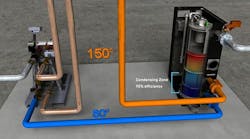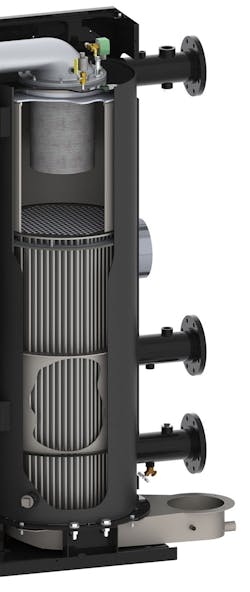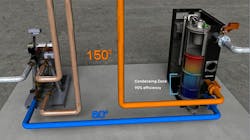When it comes to hot-water-system efficiency, most of the discussion seems to center on specifications associated with boilers and water heaters. For maximum operational efficiency to be achieved, consulting-specifying engineers and facility owners and managers need to consider overall system design as well. Utilizing dual returns when configuring a hot-water system can result in an 8-percent improvement in efficiency, compared with more traditional single-return designs commonly used in facilities, helping to lower operating expenses.
The benefits of condensing and fully modulating boilers are well-known within the industry. The modulating capability of these units, which were introduced to the market more than 25 years ago, has been enhanced over the years to the point that a few commercial boilers can achieve high burner turndown rates of 15:1 or more and published efficiency ratings of 95-plus percent. In practice, however, actual performance does not always meet the expected numbers. Utilizing dual returns can help to fulfill the promise of published ratings throughout the year.
Dual-Return Systems
Dual returns enable engineers to take full advantage of premium boilers because they enable the most efficient system to be designed. Separate piping for colder return water improves overall-system plant thermal efficiency and extends condensing-mode operating hours. This translates to significant energy savings and lower operating costs.
These advantages are realized because dual returns overcome the limitations of traditional boilers with single returns. Most standard hydronic systems blend returns from different loops, compromising the performance of a condensing-boiler system. Using such a conventional unit limits engineers to designing generic applications that force the mixing of hot and cold water. Such an approach lowers system efficiency because the condensing zone of the heat exchanger is smaller and less efficient.
A high-efficiency boiler with dual returns allows engineers to take advantage of diverse load demands specific to a site and design a customized system to optimize operation.
The concept of dual return is straightforward: The combination of a fire-tube heat exchanger constructed to operate in condensing mode and for maximum heat transfer and high-end fire tubes is used to connect a cold (less than 130°F) return to a lower inlet connection and connect a high-temperature (greater than 140°F) return to an upper inlet connection. This achieves true condensing performance, even in applications with varying flow configurations between lower and upper inlet connections. The result is a larger condensing zone that enhances boiler efficiency (Figure 1).
Boilers able to accommodate dual returns have a unique baffle design. The units’ lower baffle must ensure flow through the tube bundle for optimal heat transfer, as well as isolate the lower return-temperature zone from the higher return-temperature zone within the heat exchanger (Figure 2). This ensures the lower section of the heat exchanger handles only colder return water, which allows for greater condensing. The result is enhanced efficiency, before the water is blended with higher-temperature return water on the other side of the baffle.
Dual-Return Applications
Dual returns are ideal for systems with multiple return-water temperatures, which inherently have higher temperature differentials with lower return temperatures. They also are advantageous in applications including combination systems. Leveraging the typical lower return temperatures with high-efficiency indirect water heaters, combination systems provide a cost-saving solution for efficient space heating and domestic hot water. Figure 3 shows a typical water-heater/boiler combination system with dual returns. Energy savings from these configurations can lower annual operating costs by thousands of dollars. Additionally, dual returns can save money in radiant floor heating, pool heating, snow melt, air pre-heating, and supplementary heat for heat-pump-system applications.
One example of where the benefits of dual returns can be seen is a domestic-water-heating combination system that has high-temperature space heating plus domestic-hot-water and pool heating. The return temperatures from the high-temperature loop are high enough to supply heat for both the domestic-hot-water loop utilizing high-efficiency water heaters and the pool-heating loop. The returns from both the domestic-hot-water loop and the pool-heating loop, with even lower temperatures, are connected to the low-temperature connections of the boilers for additional efficiency gains.
Installation Flexibility
Hot-water systems incorporating dual returns provide installation flexibility as well. There are no minimum return-temperature limitations, as with some conventional single-return systems, and multiple flow configurations are possible.
Another installation advantage is there is no minimum flow requirement for the primary low-temperature return, as long as the minimum flow requirements of the boiler models are met through the secondary high-temperature return. If the flow split between the high- and low-temperature returns is constant, the total flow must be no less than the minimum flow requirements of the boiler models. With dual-return systems, engineers must remember to install check valves at both return connections to prevent crossflow between the returns should there be no flow in one of the return connections.
O2-Trim Technology
To experience up to an additional 2-percent improvement in efficiency, oxygen- (O2-) trim technology can be integrated into boilers implemented in a dual-return system. Part of advanced combustion-control systems, O2 trim automatically maintains precise air-fuel ratios for peak efficiency, low emissions, and maximum uptime reliability. It is necessary because gas- and oil-fired boilers often deviate from the ideal air-fuel ratio because of such environmental variations as humidity, atmospheric pressure, filter-dust loading, and delivered gas energy content. The result is unstable combustion, increased emissions, and possible flame loss.
O2 trim monitors the actual conditions of a boiler and adjusts the unit’s combustion process to ensure the system is operating at optimal O2 levels and peak system efficiency. O2 levels that are too low can cause unstable combustion that results in faults and increases unscheduled maintenance. O2 trim automatically changes boiler blower speed to increase O2 and return to optimal levels.
In instances in which O2 levels are too high, the dew point will be lower and the boiler will be less likely to condense, as shown in Figure 4 (based on 2013 ASHRAE Handbook—Fundamentals Chapter 28 Figure 4). O2 trim will adjust the boiler’s blower speed to decrease O2 levels to create a larger condensing zone and maximize efficiency.
Conclusion
Engineers, facility owners, and operations managers have a common goal of maximum efficiency in hot-water systems. To achieve this objective, which brings with it considerable financial savings because of lower operating costs, they should consider dual returns and O2 trim. Both help to maximize the performance of high-turndown condensing boilers and can be part of a new generation of systems that are better for the environment and an organization’s bottom line.
Nery D. Hernandez, LEED AP BD+C, is product-solutions manager, commercial boilers, for AERCO International. He has a bachelor’s degree in mechanical engineering and a master’s degree in engineering management from Stevens Institute of Technology.
Did you find this article useful? Send comments and suggestions to Executive Editor Scott Arnold at [email protected].













